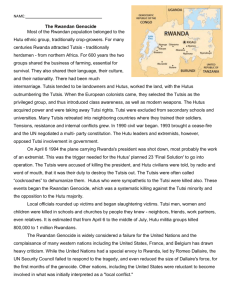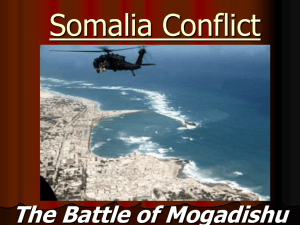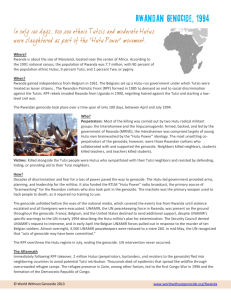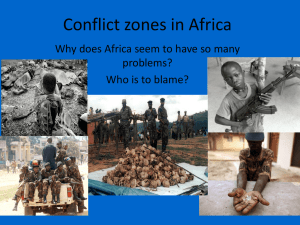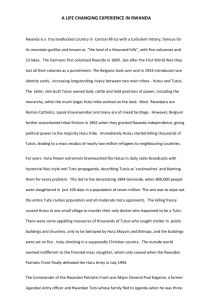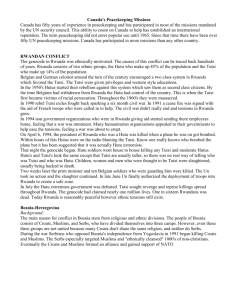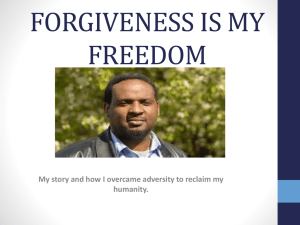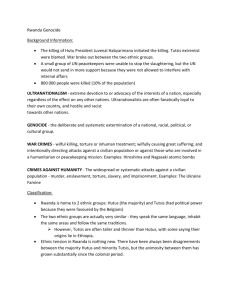The Rwandan Genocide, 1994
advertisement
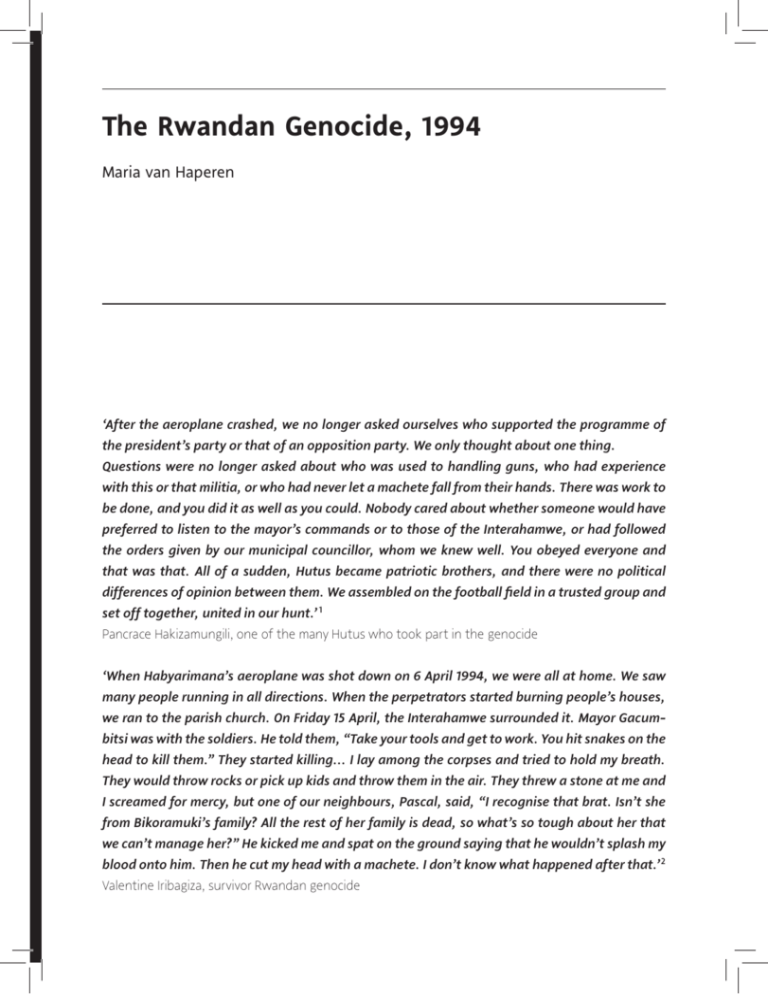
The Rwandan Genocide, 1994 Maria van Haperen ‘After the aeroplane crashed, we no longer asked ourselves who supported the programme of the president’s party or that of an opposition party. We only thought about one thing. Questions were no longer asked about who was used to handling guns, who had experience with this or that militia, or who had never let a machete fall from their hands. There was work to be done, and you did it as well as you could. Nobody cared about whether someone would have preferred to listen to the mayor’s commands or to those of the Interahamwe, or had followed the orders given by our municipal councillor, whom we knew well. You obeyed everyone and that was that. All of a sudden, Hutus became patriotic brothers, and there were no political differences of opinion between them. We assembled on the football field in a trusted group and set off together, united in our hunt.’ 1 Pancrace Hakizamungili, one of the many Hutus who took part in the genocide ‘When Habyarimana’s aeroplane was shot down on 6 April 1994, we were all at home. We saw many people running in all directions. When the perpetrators started burning people’s houses, we ran to the parish church. On Friday 15 April, the Interahamwe surrounded it. Mayor Gacumbitsi was with the soldiers. He told them, “Take your tools and get to work. You hit snakes on the head to kill them.” They started killing... I lay among the corpses and tried to hold my breath. They would throw rocks or pick up kids and throw them in the air. They threw a stone at me and I screamed for mercy, but one of our neighbours, Pascal, said, “I recognise that brat. Isn’t she from Bikoramuki’s family? All the rest of her family is dead, so what’s so tough about her that we can’t manage her?” He kicked me and spat on the ground saying that he wouldn’t splash my blood onto him. Then he cut my head with a machete. I don’t know what happened after that.’ 2 Valentine Iribagiza, survivor Rwandan genocide 98 Introduction The 1994 Rwanda genocide was the result of an economic crisis, civil war, population growth and a struggle for state power. The president of Rwanda at the time, Juvénal Habyarimana, had decided, after long opposition, to comply with the Arusha Accords and put an end to the crisis and civil war. The civil war began when the armed wing of the Rwandan Patriotic Front (RPF) invaded from Uganda in the autumn of 1990. The RPF was a movement mainly made up of the Tutsi refugee diaspora in Uganda with which Habyarimana´s party, the National Revolutionary Movement for Development (MRND), had been forced to compromise. On 6 April, he flew back from negotiations in the Tanzanian capital, Dar es Salaam. His aeroplane was shot down as it came into land, and the president and a number of other top officials were killed. After the announcement of the death of the president, all hell broke loose in Rwanda. A group of senior military officials quickly seized power. Almost immediately, organised massacres of Tutsi and moderate Hutu began, initiated by the army and the Interahamwe and Impuzamugambi youth militia. It was not immediately clear what exactly was happening. The images on the news showed long queues of people fleeing the country, carrying their household effects. Young shabbily dressed men called heatedly for ‘Hutu power,’ waving machetes or holding huge weapons aloft and firing into the air. Piles of corpses lay along the sides of roads and in ditches, but there was a lack of clarity in the media’s observations and analyses. People spoke of the Hutu and the Tutsi, and by referring to the chaos as an intertribal dispute, US President Bill Clinton confirmed people’s prejudices about Africa. 1. Historical background Rwanda is situated in the Central African Great Lakes Region, close to the equator. It is not a large country; it is around 10% smaller than Belgium. Rwanda is a lush country, covered in numerous hills. It is quite fertile by African standards, and there are many swamps, lakes and rivers. Centuries ago three peoples settled in the area that comprises present-day Rwanda and Burundi: the baTwa in the 6 th century, followed by the baHutu in the 7th century, and the baTutsi3 in the course of the 8 th and 9 th centuries. The majority of the population made a living out of agriculture: the Hutu were predominantly crop cultivators and came from the North West. The Tutsi were cattle farmers and came from the regions to the south and east of Lake Victoria (Tanzania). The Twa were a pygmy people who made a living from hunting, gathering and pottery-making. The Twa lived in the forest-covered mountains, isolated from the Hutu and Tutsi. Many Tutsi travelled through the area with large herds. As agriculturalists, the Hutu lived in permanent settlements. 1.1 Early power structures Both the Hutu and the Tutsi lived in clans that had their own leaders. The power structures within these clans were hierarchical; the people were subservient to their clan leaders. Initially, the possession of cattle conferred status. In the 19 th century, agricultural land and armies also increasingly contributed to a clan leader’s power. Clan leaders showed loyalty to the king, the mwami, who came from the Tutsi community. While an absolute monarchy did not develop, a centralised society with socially distinct communities did evolve in Rwanda. However, clan leaders maintained a degree of autonomy within the system. At the end of the 19 th century social status became increasingly linked to being ‘Hutu’ or ‘Tutsi’. The Hutu were generally seen as ‘the masses’, because few people owned cattle. In the course of time, a Hutu who obtained cattle would be seen as a Tutsi. If a Tutsi lost his cattle, he could be demoted to being a Hutu. Mixed marriages between Hutu and Tutsi were common. 1.2 Influence of colonialism – defining ‘race’ At the Berlin Colonial Conference of 1884-1885, the territory of Rwanda was awarded to Germany. As the Germans did not exercise any direct power, but instead attempted to establish colonial rule via local leaders, the mwami was urged to strengthen and centralise his authority. Colonial concepts were based on racist views. Drawing on the theory that the Hamites, a people who were related to whites, had brought civilisation to Africa, the Germans chose the Tutsi over the Hutu as the supposed descendants of the Hamites. The German colonisers strengthened the predominant position of the Tutsi. Hamitic Myth The Hamitic hypothesis states that ‘everything of value ever found in Africa was brought there by the Hamites, allegedly a branch of the Caucasian race.’4 This 19th Century racist theory was named after Noah’s son Ham from the Old Testament. According to this theory, the Hamites came to North Africa during the Stone Age, and spread to the rest of the continent from there. Moving south, the Hamites mixed with the indigenous black peoples of Africa. Racial theory was used to justify European imperialism, in the ideas of French diplomat and politician Arthur de Gobineau (1816-1882). De Gobineau divided mankind into a three-race hierarchy. The Caucasian (Europid) race, according to his theory, was superior. Then came the Mongoloid race, followed by the inferior Negroid or black race. After the First World War, under the terms of the Treaty of Versailles (1919), Germany was forced to relinquish its colonies. The League of Nations decided to place Rwanda and Burundi under Belgian auspices. Under Belgian rule, the difference in status between the Hutu and Tutsi became socially fixed. A then popular pseudo-scientific, racist method of taking skull and nose measurements was used to determine whether one was a Hutu or a Tutsi. Based on external characteristics, the ethnic origins of all citizens – Hutus, Tutsi and also the Twa – were recorded on their personal identity cards. The entire population was divided into ethnic groups and this was applied to every single aspect of life, including employment agreements 99 100 and contracts. The Hutu and Tutsi stereotypes would have far-reaching consequences. The Belgian government only appointed members of the Tutsi elite as officials or mayors. As only the Tutsi had access to schooling, the right to collect taxes and the right to move freely, Tutsi loyalty to the colonial power was guaranteed. The poor masses consisted mainly of Hutus, and Hutu frustrations grew over many years. 2. Independent Rwanda From the mid-1950s, a move towards decolonisation took place across nearly all of Asia and Africa. Belgium experienced a particularly tumultuous period in its colonies. The pursuit of independence by many highly-educated Tutsi led to a cooling of relations with the Belgians. The Belgian government was keen to avoid a war of independence and somewhat unexpectedly dropped its policy of favouring the Tutsi. Now, Hutus were admitted to functions and organisations that had until recently been reserved for Tutsi. In 1957, with the approval of the Belgian government, the Party of the Hutu Emancipation Movement, MDR-Parmehutu, was founded. These developments put a strain on social relations, especially when it became clear that the Hutu were aiming for independence. The Hamitic myth, which had long worked in the Tutsi’s favour, now played against them. MDR-Parmehutu leaders proclaimed aggressively that a people that originated in North Africa did not belong in Rwanda. The Tutsi felt threatened. When the mwami, the old Tutsi king, died in 1959, the Hutu rose up in revolt against the Tutsi, and the Hutu social revolution was declared. The revolution ended in the first wave of massacres. Thousands of Tutsi were killed during the violence. For the Belgians, it was clear that their colonial powers had come to an end. Elections had to be held. The Belgian government returned its mandate to the United Nations, the successor to the League of Nations. In the 1960 elections, MDR-Parmehutu emerged as the winner. The result was the immedi- ate overthrow of the monarchy. Tutsi leaders were replaced with Hutu leaders, and tens of thousands of Tutsi fled the country. In July 1962, Rwanda and Burundi celebrated their independence. The separation of the two countries by the United Nations was followed by rioting. In 1963, Tutsi fighting units attempted to overthrow the regime of the new president, Grégoire Kayibanda of the MDR. But President Kayibanda succeeded in mobilising the existing mainly-Hutu population by playing on fears of renewed Tutsi tyranny. During those days, Kayibanda spoke of the Tutsi as ‘cockroaches’, vermin that must be exterminated. The Hutu reacted to these words by driving the Tutsi out of their houses and villages. In what became a true exodus, around 300,000 Tutsi fled to Uganda, Tanzania and Burundi. In a repeat of the events at the end of the 1950s, tens of thousands of Rwandan Tutsi were killed, their possessions confiscated by Hutus and by the Rwandan government. 101 Mwami Mutara III, Tutsi king between 1931 and 1959 Source: Kigali Genocide Memorial Centre 2.1 Rwanda under Habyarimana Kayibanda’s successor, Juvénal Habyarimana, came to power in 1973 by means of a coup d’état. Like Kayibanda, Habyarimana’s politics were based on ethnic divide and rule. He stuck to the system of ethnic identity cards from the colonial period, now reversed and favouring Hutu over Tutsi. Tutsi participation in education was limited, while mixed marriages were officially outlawed in 1976. Habyarimana also confiscated people’s possessions. Some Tutsi were forcibly ‘relocated’ to heavily forested provinces that had to be cultivated. Ethnically motivated killings also took place in the 1970s. Despite this, the Tutsi minority was relatively safe compared to the situation in the 1950s and 1960s. Habyarimana even favoured a small group of Tutsi, particularly businessmen. In the 1980s, Rwanda’s economy developed into one of the most stable economies in Africa. However, in the mid-1980s, four out of five families still lived in rural areas, and nine out of ten families made a living from agriculture. Figures from 1991 report that the population of Rwanda was around eight million, with 89.9% Hutu and 9.8% Tutsi; the remaining 0.4% was made up of Twa. 3. The prelude to genocide At the end of the 1980s, the economy went into a free-fall. Poor harvests led to food shortages. The combination of hunger and the high population density, the growing trade deficit, and in- 102 creasing corruption and personal enrichment among the elite led to social unrest. Habyarimana was openly criticised, a striking development given that there was no freedom of speech in Rwanda. The French government, which felt partly responsible for African political relations, put pressure on Habyarimana to introduce a multi-party system. From 1991, new radical Hutu parties competed with Habyarimana’s MRND for popular support. Habyarimana’s politics soon took an extreme course. By 1990, about one million Rwandan Tutsis were living in exile. The militants among them (including the current president of Rwanda, Paul Kagame) founded an emancipation movement called the Rwandan Patriotic Front (RPF). Their goal was to overthrow Habyarimana and his predominantly Hutu government, and to clear the way for the return of Tutsi exiles from abroad. From October 1990 onwards, RPF militants from Uganda returned to Rwandan territory and blended in with the Tutsi population. The militants called themselves Inkotanyi. In 1992, they succeeded in occupying various northern Rwandan provinces, to the horror of both Hutu and Tutsi, who were fearful of reprisal attacks by both the Rwandan army and the RPF. These fears were justified. The Rwandan army struck with a vengeance. Hundreds of Tutsi were killed; the violence went unpunished. Radical Hutu set up their own fighting units to deal with what they called ‘unpatriotic elements’. In response, Habyarimana’s party created its own paramilitary organisation, the Interahamwe. In 1992, the growing Rwandan army, supported by French ‘advisors’, was able to halt the ad- vance of the RPF. At this time, Central Africa was plagued by social unrest. The United Nations (UN) turned its attention to the region, and as a result, Habyarimana was forced to join the RPF’s leaders at the negotiation table in Arusha, Tanzania, supervised by the UN. Now Habyarimana found himself in a difficult position. While the international community expected him be moderate, his domestic political rhetoric turned extremist. The Tutsi became a scapegoat in Rwandan society. Arusha Accords The Arusha Accords are a power-sharing agreement signed in Tanzania in 1993 under international pressure. The aim of these Accords had been to bring about a peaceful end to the situation of crisis and civil war in Rwanda, starting with the formation of a transitional government in which almost all parties involved would participate. 4. Ideology, propaganda and hate campaigns With Habyarimana’s approval, a propaganda campaign began, aiming to alienate the Hutu from the Tutsi. The Tutsi, as a scapegoat, were criminalised; a tried-and-tested method that had previously been used by Lenin and Hitler. Kangura (Wake Up), an influential Rwandan newspaper, published the ‘Hutu Ten Commandments’. These set out rules for Hutu contact with the Tutsi. 103 Interahamwe, 1993 Source: Kigali Genocide Memorial Centre Arusha Accords, front left Habyarimana, August 4, 1993 Source: Kigali Genocide Memorial Centre 104 Hutu Ten Commandments, Kangura, No 6, 1990 Source: Kigali Genocide Memorial Centre Hutu Ten Commandments 1. Every Hutu should know that a Tutsi woman, wherever she is, works for the interest of her ethnic Tutsi group. Consequently, we should consider a traitor every Hutu who: a. marries a Tutsi woman; b. befriends a Tutsi woman; c. employs a Tutsi woman as a secretary or concubine. 2. Every Hutu should know that our Hutu daughters are more suitable and dutiful in their roles as women, wives and mothers of the family. Are they not more wonderful, good secretaries and more honest? 3. Hutu women, be vigilant and try to bring your husbands, brothers and sons back to reason. 4. Every Hutu should know that every Tutsi is dishonest in business. Their only aim is supremacy for their ethnic group. As a consequence, every Hutu is a traitor who does the following: a. makes a business partnership with a Tutsi; b. invests his money or that of the government in a Tutsi enterprise; c. lends money to or from a Tutsi; d. gives business favours to a Tutsi (obtaining import licences, bank loans, construction sites, public markets etc.). 5. All strategic posts, political, administrative, economic, military and these in the area of security, should be entrusted to Hutus. 6. The majority of the education sector, i.e. school pupils, students, teachers, must be Hutu. 7. The Rwandan armed forces should be exclusively Hutu. The experience of the October War has taught us a lesson. No member of the military shall marry a Tutsi. 8. Hutus should stop having mercy on the Tutsi. 9. The Hutus must, whoever they are, maintain unity and solidarity and be concerned with the fate of their Hutu brothers; a. The Hutus in and outside Rwanda must constantly look for friends and allies for the Hutu cause, starting with their own Bantu brothers; b. They must constantly counteract Tutsi propaganda; c. The Hutus must be firm and vigilant against their common Tutsi enemy. 10. The Social Revolution of 1959, the Referendum of 1961 and Hutu ideology must be taught at every level to every Hutu. Every Hutu must spread this ideology widely. Every Hutu who persecutes his Hutu brother because he has read, spread and taught this ideology is a traitor. 105 106 The Hutu Ten Commandments aimed to convince the Hutu population that the Tutsi were their archetypal enemies. The propaganda evoked images of war, slavery, oppression, injustice, death and cruelty. Fabricated images of non-existent RPF munitions depots, for example, or shady suspect Tutsi, led Hutus to be fearful and arm themselves in order to protect and defend themselves against the Tutsi enemy. Despite poor distribution, Kangura reached a wide audience. Other newspapers and maga- zines copied reports that appeared in Kangura. Despite the fact that only 66% of Rwandans could read, the propaganda was highly effective: the articles were lavishly illustrated with cartoons that communicated an unmistakably malicious message. Moreover, the Rwandan oral culture meant that the Hutu Ten Commandments were passed on to many illiterate people. Because of the high rate of illiteracy, the radio was the most successful tool for propaganda. In 1991, only 29% of all households owned a radio, but Rwandans who did not have radios listened to broadcasts in local cafes or elsewhere. Until 1992, the country’s only station, Radio Rwanda (NNR), mainly broadcast presidential addresses, official governmental announcements, exam results and censored news bulletins. An independent radio station did not exist. When, in 1991, the RPF put its own station, Radio Muhabura, on air, it quickly caught on among Rwandans. In response to this the government founded Radio Télévision Libre des Mille Collines (RTLM). The hugely popular musician Simon Bikindi and all of the RTLM shareholders came from the elite that surrounded Habyarimana. RTLM was soon drawing a large audience. The station’s lively music and informal style of presentation encouraged people to tune in. RTLM news bulletins and local news flashes were full of gossip and scandal. Members of the audience were encouraged to phone in, and the callers were put live on air. The Rwandan intelligentsia was also influenced by the propaganda. Since the educational system was funded by the government, most lecturers saw little room for an independent or critical stance. One of the most influential professors, Léon Mugesera, a hard-line Hutu propagandist made the infamous speech: ‘Do not let yourselves be invaded’. Excerpts of the speech by Léon Mugesera on 22 November 1992 I know you are men [...] who do not let themselves be invaded, who refuse to be scorned. […] Why do they not arrest these parents who have sent away their children and why do they not exterminate them? Why do they not arrest the people taking them away and why do they not exterminate all of them? Are we really waiting till they come to exterminate us? […] Rise up [...] really rise up. If you are struck once on one cheek, you should strike back twice.[...] Know that the person whose throat you do not cut now will be the one who will cut yours. […] If one day someone attacks you with a gun, you will not come to tell us that we [...] did not warn you of it! 107 The Rwandan newspaper Kangura Photo: Thijs B. Bouwknegt Mugesera called for self-defence, on the grounds that the enemy was out to destroy all Hutus. Quoting from the Bible, Mugesera gave an unusual twist to the principle of ‘turn the other cheek’; this became, ‘if you are hit on one cheek, hit back twice’. Parts of this speech were broadcast on 22 November 1992, eighteen months before the genocide. 5. United Nations and UNAMIR While the propaganda machine was operating at full force and Hutu extremists were calling for ‘Hutu power’, the international community focused its attention on Rwanda. A classified CIA report (January 1993) referred to massive arms purchases – consignments of guns, hand grenades and machetes. The United Nations took the explosive situation to heart and sent observers. The United Nations Assistance Mission for Rwanda, UNAMIR, was installed to help implement a transitional government as agreed in the Arusha Accords. The UNAMIR mandate consisted of peacekeeping, disarmament, supervising the ceasefire and reporting incidents. It was also supposed to assist with the repatriation of refugees and to coordinate humanitarian 108 Hutu propaganda. ‘I am sick, doctor’, ‘Do you know what makes you sick?’, ‘The Tutsis, the Tutsis!!!’ Photo: Thijs B Bouwknegt aid. The mandate explicitly excluded intervention in conflicts. UNAMIR was headed by the Canadian General Roméo Dallaire. He had 2,548 troops of 26 different nationalities under his command. The former coloniser Belgium also sent troops, even though this was actually not permitted under UN regulations. Belgium provided a battalion of 450 troops and a paramilitary commando. UNAMIR’s equipment was inadequate and the mission had a low status. On the eve of the genocide in Rwanda four different groups were competing for power in the political and social arena. Firstly the moderate Hutus led by Prime Minister Uwilingiymana and supported by UNAMIR. Then there were Hutu extremists, supported by the army, the Interahamwe and other youth militias, and also by the media (such as Kangura, RTLM, NNR). Thirdly there was the RPF, and lastly UNAMIR. Uwilingiymana’s transitional government, the small moderate Hutu parties and UNAMIR followed the same lines. The Hutu extremists and the RPF were diametrically opposed. As the Hutu extremists called for ‘Hutu power’, lists of the names of the president’s political opponents were ready and waiting in Kigali. Habyarimana wanted to maintain his power at any cost. 6. Genocide On the evening of Wednesday 6 April 1994, the presidential aeroplane approached the airport of Kigali. On board were the Rwandan president Juvenal Habyarimana, Chief-of-Staff of the Rwandan army General Deogratias Nsabimana, President Cyprien Ntayamira of Burundi and other Rwandan political and military authorities. They had been at a meeting of heads of state from the region at which Habyarimana had finally agreed to implement the Arusha Accords. While the French air crew started on the long descent, two missiles were fired from the ground close to the airport. The first missile hit a wing, the second the aircraft’s tail. According to eyewitnesses the plane caught fire immediately and after an enormous explosion landed in the grounds of 109 Fragment ICTR Cartoonbook p. 15 Source: ICTR 110 the nearby President’s palace. No one in the plane survived the crash. Immediately after Habyarimana’s death UNAMIR General Roméo Dallaire went to the Rwandan Army’s headquarters, where he met Colonel Théoneste Bagosora, a Hutu hardliner. Dallaire stated that Habyarimana’s death meant that Prime Minister Agathe Uwilingiyimana had automatically become the legal head of state. 6.1 The killing starts in Kigali In the hours following Habyarimana’s assassination, Rwandan military units moved through Kigali. Within twelve hours many Tutsi elite and all moderate Hutus in influential positions in Kigali were murdered. Among the first victims were Prime Minister Agathe Uwilingiyimana and her husband, the Minister of Agriculture, and the Minister of Labour. The fifteen UN soldiers guarding the Prime Minister were imprisoned. Within a few hours the streets of Kigali had been taken over by armed Hutus who put up road blocks to prevent anyone from escaping the city. The streets of Kigali were systematically ransacked, and all suspect Tutsi or moderate Hutu were killed. The RTLM radio station started to name Tutsi and moderate Hutu with their addresses and number plates during their broadcasts. If your name was mentioned on the radio, everyone immediately understood that you were being looked for and would be killed by the Interahamwe. Right from the beginning of the genocide, the RTLM supported the Interahamwe by passing on information during broadcasts about the direction in which victims were trying to escape. After a few days thousands of decomposing corpses were piled high in the streets of Kigali. 6.2 Genocide in rural areas About a week after the outbreak of mass violence in the capital, massacres started to take place in rural areas. This illustrates how carefully things were planned in advance. Orders were passed down from above through the administrative machinery. Prefects informed mayors and subprefects, who in turn explained to their closest staff members how the commands were to be passed on to the actual murderers. In most cases school and hospital directors, local councillors and businessmen were involved in the murder plans. Because of their authority and influence they were instrumental in inciting ordinary people to carry out the killing. ‘They told where to go to kill and which route to take down into the marshlands. …Then we separated into small groups of acquaintances or friends. It was a collusion that didn’t cause any problems. Except on busy days, when Interahamwes with motor vehicles came from the surrounding regions as back-up for a big operation. Those men were so fired up they made it hard for us to work. The councillor told us all we were expected to do was kill Tutsi. We understood very well that fixed plans had been made. […] So the only questions asked were about organisational details, such as how, when and also where we were supposed to start, because we were not used to operations like this, and the Tutsi had escaped in all 111 Victims, Kigali Genocide Memorial Centre Photo: Thijs B. Bouwknegt directions. Someone even asked if there were preferences. The councillor replied sternly: “The question is not where you should start, the only right way is close by, in the bush, and right now, without asking any questions.[…]”’5 Genocidaire Whereas in Kigali the murderers had been well-equipped government troops and militiamen with automatic rifles and hand grenades, in rural areas simple farmers murdered with machetes, knives, spears, wooden clubs studded with nails, and screwdrivers. Because initially the murderers were not very skilled or experienced, these primitive methods of massacre were bloodier than in the capital. ‘At first we were too fired up to think. Later it had become too much of a habit. In the 112 state we were in it meant nothing to us that we were chopping off all our neighbours’ heads. It had become a matter of course. By then they were no longer our good neighbours from way back who used to pass us the bottle at the pub, because they were no longer allowed to go there. They had become people who had to be cleared away, so to speak. They were no longer what they had been, and neither were we. We didn’t feel bothered by them or by the past, because we didn’t feel bothered by anything.[…] We had to leave any friendly feelings behind at the edge of the swamp until the signal had been given that our work was finished. Good manners were not permitted in the swamp either. No exceptions were possible in the swamp. We were so ferocious and hardened that we just kept killing and because of that forgot about any doubts.[…] Some men started on the hunt in good spirits and finished in good spirits. And other men were never keen at all and killed because they were obliged to.[…] The more you killed, the more you were urged on by greed to continue.[…] A man can get used to killing if he constantly kills. He can even become a wild beast and not pay any attention to it. Some men started to threaten each other when there were no more Tutsi to use their machetes on. You could see from their faces that they felt the need to kill.’6 Genocidaire The RTLM played a different role in spreading the genocide in rural areas. In Kigali the Interahamwe and Impuzamugambi were informed through RTLM radio about which Tutsi were trying to escape by pretending to be Hutu, but in the countryside hills people knew each other’s ethnicity. Genocidaires knew their victims, they lived near and with each other, helped each other, had listened to the radio together in cafes. They were neighbours, knew each other’s children and grandchildren, or had been to school together. For days and weeks in succession victims sought shelter in the marshes, steeped in mud, hiding behind eucalyptus trees and banana leaves. After the genocidaires had returned home the Tutsi came out of their hiding places to count the dead. In the evening they shared their food and went to look for water for yet another day of killing. Some died of exhaustion, some surrendered to the murderers to be killed so as to be delivered from their misery. ‘The morning after the President’s plane was shot down, I was in my uncle’s house with five cousins. The Interahamwe came, saying they were going to rape the girls. Uncle Gashugi pleaded with them not to do it, but they cut him down with a machete. I ran out of the back door with the others. All the other girls were killed before they reached the gate. I’m the only one of the household who survived. I went from house to house, like a hunted animal. Sometimes I hid in the drains with the corpses, pretending to be dead myself.’ 7 Béatha Uwazaninka, survivor Rwandan genocide It was easier to hide in the countryside than it was in Kigali. Escaping the city was virtually impossible because of the many roadblocks. In the country the victims were relatively safe at night. Sometimes young women survived after being sexually abused by Hutu, but often rape was followed by murder. Between 6 April and the end of June 1994, in just 100 days, approximately three quarters of the total Tutsi population of Rwanda was killed. Estimates of the number of victims vary between 507,000 (Human Rights Watch’s historian and ICTR expert witness Alison Des Forges) and 1.2 million (Rwandan government). The latter figure includes the ongoing killings in the refugee camps in Congo. In the subsequent months, large-scale crimes were again committed, but now Hutus were the victims and most of the perpetrators were RPF fighting units. In July 1994 more than two million Hutus took flight and hundreds of thousands of Tutsi came to Rwanda from neighbouring countries. 7. Aftermath On 8 November 1994 the UN Security Council decided to set up a tribunal to prosecute persons responsible for genocide and other serious violations of international humanitarian law committed in Rwanda and abroad between 1 January and 31 December 1994. Rwanda, a temporary council member in 1994, was the only country to vote against the tribunal. The International Criminal Tribunal for Rwanda (ICTR) was established in Arusha, Tanzania, in the same building where the Arusha Accords were signed. It has to complete its work by 2013. Gacaca After the genocide, more than 100,000 Hutu were imprisoned on suspicion of having participated in the 1994 genocide. It would have taken decades to bring each alleged perpetrator to justice individually. Also, these men were needed to rebuild the country. National means of coming to terms with the atrocities came from the traditional community-based gacaca courts. The gacaca courts aimed to reveal the truth about what has happened, to speed up the genocide trials, to eradicate the culture of impunity and to reconcile the Rwandans and reinforce their unity. Some 12,000 gacaca courts dealt with over a million cases. ‘There are still people with such bestial hearts; people who killed. You can tell they would do it again. Reconciliation is not the problem. The problem is that those who killed, ate our cattle and took our things, run away from us. I don’t know how we can forgive when there hasn’t been any communication between us. There are lots of people like that who look at you and wish you were dead.’8 Emmanuel Mugenzira, survivor Rwandan genocide 113 114 Gacaca Hearing (above) and Court (below) Photo: Thijs B. Bouwknegt 115 Gacaca Judges Photo: Thijs B. Bouwknegt The current Rwandan president Paul Kagame strongly denies the charge that the crimes of the RPF against the Hutus were genocidal in nature. The academic and political discussion is still in full swing. 7.1 International Responses, Intervention and prevention The international community had been painfully unable to intervene or prevent the atrocities. It was unable to draw the right conclusions on time. In the first days of April 1994, the term ‘ethnic cleansing’ was used instead of genocide. UN General Roméo Dallaire, probably the bestknown witness (‘bystander’) to the genocide, said that although he was initially appalled by the murders, he had the impression that the Rwandan army and the Interahamwe were attacking political enemies of Habyarimana. It was only in the course of several days that it began to dawn on him that crimes against humanity were being committed and that all Tutsi were being targeted. He only realised this when he actually saw Interahamwe pulling people with Tutsi ID cards out of their cars at roadblocks and murdering them on the spot. ‘I just needed a slap in the face to say, “This is genocide, not just ethnic cleansing”. […] I­ was self-conscious about saying the killings were “genocidal” because genocide was the equivalent of the Holocaust or the Killing Fields of Cambodia – I mean millions of people. […] “Ethnic cleansing” seemed to involve thousands of people. Genocide was the highest scale of crimes against humanity imaginable. It was so far up there, so far off the charts, that it was not easy to recognise that we could be in such a situation.’ General Roméo Dallaire
